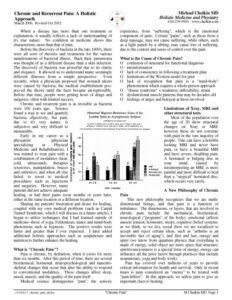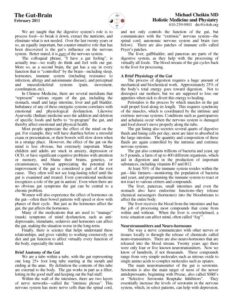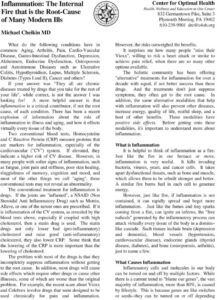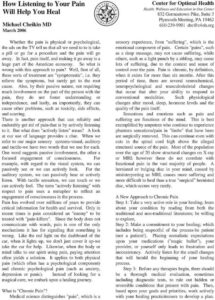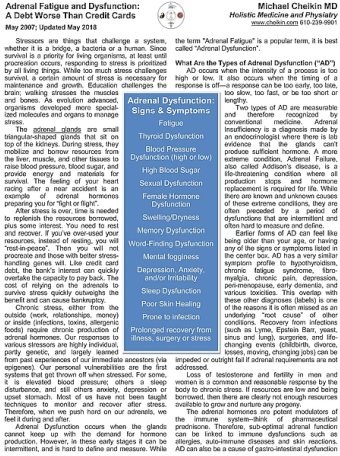Pain, Fatigue & Fibromyalgia
Updated May 4, 2023
Chronic fatigue syndrome is characterized by persistent, recurrent and unexplainable chronic fatigue not due to an ongoing period of effort, not relieved by rest, and is functionally disabling. Establishing this diagnosis requires the presence of at least 4 of the following associated symptoms: 1) patient report of a deterioration in short-term memory that is functionally limiting; 2) pharyngodynia; 3) cervical or axially lymphadenopathy; 4) muscle pain; 5) polyarticular pain without tumefaction or reddening; 6) headaches with new characteristics or of different severity; 7) unrefreshing sleep; 8) malaise following effort and lasting more than 24 hours (post-exertional malaise).
Muscle pain is a common complaint. It is important to establish a diagnosis that is as specific as possible, so that rational treatment can be provided. Fibromyalgia is characterized by widespread muscle pain associated with fatigue, sleep disturbance, and cognitive impairment, often described as “brain fog.” As a form of peripheral and central sensitization, it is considered a disorder of the nervous system. The 2016 American College of Rheumatology diagnostic criteria for fibromyalgia require:
- Pain in at least 4 of 5 regions (left upper region, right upper region, axial region, left lower region, right lower region)
- Symptoms have been present at a similar level for at least 3 months
- Widespread pain index (WPI) 7 and symptom severity score (SSS) 5 or WPI of 4-6 and SSS 9
- A diagnosis of fibromyalgia is valid irrespective of other diagnoses. A diagnosis of fibromyalgia does not exclude the presence of other clinically relevant diagnoses.
The WPI is a tally of the number of specific areas in which the patient experiences pain. It ranges from 0-19 and includes the following areas: left/right shoulder girdle, left/right upper arm, left/right lower arm, left//right hip (buttock), left/right upper leg, left/right lower leg, left/right jaw, chest, abdomen, neck, upper back, and lower back. The SSS rates the associated symptoms of fatigue, waking unrefreshed, and cognitive symptoms on a scale from 0 (no problem) to 3 (severe, pervasive, continuous, life disturbing). The total score is a sum of the 3 individual scores. This patient with pain in 5 regions, a WPI of at least 11 (neck, upper back, lower back, both shoulders, arms, buttocks, and legs) and SSS of at least 7 (+3 for severe fatigue, +2 for often waking unrefreshed and +2 for moderate cognitive symptoms) present for 5 years has fibromyalgia.
In contrast to fibromyalgia which is widespread, myofascial pain syndrome causes local or regional muscle pain and is associated with trigger points (small, sensitive, palpable taut bands of muscle that are painful to palpation, reproduce the patient’s symptoms, and cause referred pain). Whereas fibromyalgia is a disorder of the nervous system manifesting as peripheral and central sensitization, myofascial pain is considered intrinsic to the muscles. Sleep disturbances and fatigue may also be present with myofascial pain but are typically less prominent than in fibromyalgia. Polymyalgia rheumatica is an inflammatory disorder causing pain and stiffness, often in the shoulders, and rarely affects people under 50 years old. Inflammatory markers such as erythrocyte sedimentation rate are often elevated.
References: (new tab, lightbox will not work)
Wolfe F, Clauw DJ, Fitzcharles M, et al. 2016 Revisions to the 2010/2011 fibromyalgia diagnostic criteria. Semin Arthritis Rheum. 2016 Dec; 46(3): 319-29. PMID: 27916278
Atzeni F, Cazzola M, Benucci M, Di Franco M, Salaffi F, Sarzi-Puttini P. Chronic widespread pain in the spectrum of rheumatological diseases. Best Pract Res Clin Rheumatol. 2011 Apr; 24(2): 165-71. PMID: 22094193
Borg-Stein J, Simons DG. Focused review: myofascial pain. Arch Phys Med Rehabil. 2002 Mar; 83(3 Suppl 1): S40-7, S48-9. PMID: 11973695

